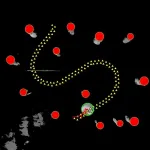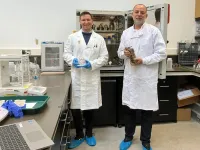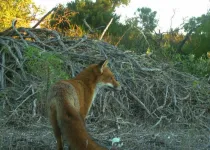(Press-News.org) In 2018, Arthur Ashkin won the Nobel Prize in Physics for inventing optical tweezers: laser beams that can be used to manipulate microscopic particles. While useful for many biological applications, optical tweezers require extremely controlled, static conditions to work properly.
“Optical tweezers work by creating a light ‘hotspot’ to trap particles, like a ball falling into a hole. But if there are other objects in the vicinity, this hole is difficult to create and move around,” says Romain Fleury, head of the Laboratory of Wave Engineering in EPFL’s School of Engineering.
Fleury and postdoctoral researchers Bakhtiyar Orazbayev and Matthieu Malléjac have spent the last four years trying to move objects in uncontrolled, dynamic environments using soundwaves. In fact, the team’s method – wave momentum shaping – is entirely indifferent to an object’s environment or even its physical properties. All the information that’s required is the object’s position, and the soundwaves do the rest.
“In our experiments, instead of trapping objects, we gently pushed them around, as you might guide a puck with a hockey stick,” Fleury explains.
The unconventional method, funded by the Swiss National Science Foundation (SNSF) Spark program, has been published in Nature Physics in collaboration with researchers from the University of Bordeaux in France, Nazarbayev University in Kazakhstan, and the Vienna University of Technology in Austria.
Very simple, very promising
If soundwaves are the hockey stick in Fleury’s analogy, then a floating object like a ping-pong ball is the puck. In the lab’s experiments, the ball was floating on the surface of a large tank of water, and its position was captured by an overhead camera. Audible soundwaves emitted from a speaker array at either end of the tank directed the ball along a pre-determined path, while a second array of microphones ‘listened’ to the feedback, called a scattering matrix, as it bounced off of the moving ball. This scattering matrix, combined with the camera’s positional data, allowed the researchers to calculate in real time the optimal momentum of the soundwaves as they nudged the ball along its path.
“The method is rooted in momentum conservation, which makes it extremely simple and general, and that’s why it’s so promising,” Fleury says.
He adds that wave momentum shaping is inspired by the optical technique of wavefront shaping, which is used to focus scattered light, but this is the first application of the concept to moving an object. What’s more, the team’s method is not limited to moving spherical objects along a path: they also used it to control rotations, and to move more complex floaters like an origami lotus.
Mimicking conditions inside the body
Once the scientists succeeded in guiding a ping-pong ball, they performed additional experiments with both stationary and moving obstacles designed to add inhomogeneity to the system. Successfully navigating the ball around these scattering objects demonstrated that wave momentum shaping could perform well even in dynamic, uncontrolled environments like a human body. Fleury adds that sound is a particularly promising tool for biomedical applications, as it is harmless and noninvasive.
“Some drug delivery methods already use soundwaves to release encapsulated drugs, so this technique is especially attractive for pushing a drug directly toward tumor cells, for example.”
The method could also be a game-changer for biological analysis or tissue engineering applications where manipulating cells by touching them would cause damage or contamination. Fleury also sees 3D printing applications for wave momentum shaping, for example to arrange microscopic particles before solidifying them into an object.
Ultimately, the researchers believe their method could also work using light, but their next goal is to take their sound-based experiments from the macro- to micro-scale. They have already received SNSF funding to do experiments under a microscope, using ultrasonic waves to move cells around.
END
Moving objects precisely with sound
EPFL researchers have succeeded in directing floating objects around an aquatic obstacle course using only soundwaves. Their novel, optics-inspired method holds great promise for biomedical applications such as noninvasive targeted drug delivery.
2024-06-25
ELSE PRESS RELEASES FROM THIS DATE:
Sustainable electrification: Managing resource demands for future electric vehicles
2024-06-25
With goals to limit CO2 emissions, many countries have set targets to phase out internal combustion vehicles in favor of electric vehicles (EVs). Japan has set a target for 20-30% of all car sales to be battery electric vehicles (BEVs) and plug-in hybrid electric vehicles (PHEVs), and 30-40% of car sales to be hybrid electric vehicles (HEVs) by 2030. The USA plans for 50% of new vehicles to be zero-emission by 2030, while Germany wants to have 15 million EVs on the road by 2030. These goals raise concerns about the raw material demand for EVs. Batteries, which account for 50% of all resources consumed in BEV production, require ...
New AI program from BU researchers could predict likelihood of Alzheimer’s disease
2024-06-25
Trying to figure out whether someone has Alzheimer’s disease usually involves a battery of assessments—interviews, brain imaging, blood and cerebrospinal fluid tests. But, by then, it’s probably already too late: memories have started slipping away, long established personality traits have begun subtly shifting. If caught early, new pioneering treatments can slow the disease’s remorseless progression, but there’s no surefire way to predict who will develop the dementia associated with Alzheimer’s.
Now, Boston University researchers say they have designed a promising new artificial ...
Telltale greenhouse gases could signal alien activity
2024-06-25
If aliens modified a planet in their solar system to make it warmer, we’d be able to tell. A new UC Riverside study identifies the artificial greenhouse gases that would be giveaways of a terraformed planet.
A terraformed planet has been artificially made hospitable for life. The gases described in the study would be detectable even at relatively low concentrations in the atmospheres of planets outside our solar system using existing technology. This could include the James Webb Space Telescope, or a future European-led space telescope concept.
And ...
New study unveils formation secrets of tiny rare earth elements
2024-06-25
Researchers from Trinity College Dublin’s School of Natural Sciences have revealed a novel route to the formation of bastnäsite, a crucial mineral for the extraction of rare earth elements (REEs). Their work offers promise in one day making the extraction of these REEs more efficient.
The study – published today in the journal Nanoscale – uncovers for first time how fluocerite, a rare mineral, quickly forms and transforms into bastnäsite. The occurrence and origin of fluocerite in natural deposits was not fully understood, ...
DOE awards Sandia small business program and local veteran
2024-06-25
ALBUQUERQUE, N.M. — The Department of Energy has once again awarded Sandia National Laboratories for its work helping small businesses. One of those businesses, owned by a disabled veteran, was also awarded for its extraordinary work.
DOE Mentor of the Year
Sandia’s small business Mentor-Protégé Program has been named as DOE Mentor of the year, an award it has received for three consecutive years.
Now in its fifth year, the program has mentored five protégés from around the country. More than 150 volunteer mentors and support personnel help these small and disadvantaged businesses grow, succeed and navigate doing business ...
Family, friends can be more effective health role models than celebrities
2024-06-25
PULLMAN, Wash. – Your mom might be a better health influencer than Dwayne “The Rock” Johnson.
Adults in a study who said they looked to a person they knew as role model for good health—such as a friend, relative or healthcare provider—rather than a celebrity, had greater motivation to reach their health goals. The women participants were also more likely than men to choose a personal role model rather than a celebrity. And the person most often named was their own mother.
“We know that parents have a huge influence on shaping people’s health trajectories throughout their life just ...
Australia’s giant lizards help save sheep from being eaten alive
2024-06-25
Giant lizards called heath goannas could save Australian sheep farmers millions of dollars a year by keeping blowfly numbers down - and must be prioritised in conservation schemes to boost native wildlife, say researchers.
A study led by the University of Cambridge has found that heath goannas - a species of giant, scavenging lizard - act as natural clean-up crews by clearing maggot-ridden animal carcasses from the landscape.
This reduces the emergence of blowflies, which attack sheep by laying eggs on their backsides that hatch into flesh-eating maggots. The disease, known as ‘fly strike’, costs the Australian sheep farming industry an estimated $280 million a year.
This ...
New tipping point discovered beneath the Antarctic ice sheet
2024-06-25
This process is currently not included in models that predict sea level rise, so the new results could offer a more accurate picture of how the world will change with global warming and how much coastal areas will need to adapt.
Carried out by scientists at the British Antarctic Survey (BAS), the findings are published in the journal Nature Geoscience.
“We have identified the possibility of a new tipping-point in Antarctic ice sheet melting,” says Alex Bradley, an ice dynamics researcher ...
Dietary fibers make our gut bacteria behave healthy
2024-06-25
We get healthy dietary fibres from consuming fruits, vegetables, and whole grains. But why are the fibres so good for us? A team of researchers has discovered that dietary fibres play a crucial role in determining the balance between the production of healthy and harmful substances by influencing the behaviour of bacteria in the colon.
Dietary fibres benefit our health, and scientists from DTU National Food Institute and the Department of Nutrition, Exercise and Sports at the University of Copenhagen have now uncovered an essential part of why this is the case. Different types of bacteria inside our colon compete to utilize an essential amino acid called tryptophan. This competition ...
Study links gut microbiome changes to increased risk of type 2 diabetes
2024-06-25
The largest and most ethnically and geographically comprehensive investigation to date of the gut microbiome of people with type 2 diabetes (T2D), prediabetes, and healthy glucose status has found that specific viruses and genetic variants within bacteria correspond with changes in gut microbiome function and T2D risk. Results of the study—which represents a collaboration across Brigham and Women’s Hospital (a founding member of the Mass General Brigham healthcare system), the Broad Institute of MIT and Harvard, and Harvard T.H. Chan School of Public Health—are published in Nature Medicine.
"The microbiome is highly variable across different geographic ...
LAST 30 PRESS RELEASES:
CHANGE-seq-BE finds off-target changes in the genome from base editors
The Journal of Nuclear Medicine Ahead-of-Print Tip Sheet: January 2, 2026
Delayed or absent first dose of measles, mumps, and rubella vaccination
Trends in US preterm birth rates by household income and race and ethnicity
Study identifies potential biomarker linked to progression and brain inflammation in multiple sclerosis
Many mothers in Norway do not show up for postnatal check-ups
Researchers want to find out why quick clay is so unstable
Superradiant spins show teamwork at the quantum scale
Cleveland Clinic Research links tumor bacteria to immunotherapy resistance in head and neck cancer
First Editorial of 2026: Resisting AI slop
Joint ground- and space-based observations reveal Saturn-mass rogue planet
Inheritable genetic variant offers protection against blood cancer risk and progression
Pigs settled Pacific islands alongside early human voyagers
A Coral reef’s daily pulse reshapes microbes in surrounding waters
EAST Tokamak experiments exceed plasma density limit, offering new approach to fusion ignition
Groundbreaking discovery reveals Africa’s oldest cremation pyre and complex ritual practices
First breathing ‘lung-on-chip’ developed using genetically identical cells
How people moved pigs across the Pacific
Interaction of climate change and human activity and its impact on plant diversity in Qinghai-Tibet plateau
From addressing uncertainty to national strategy: an interpretation of Professor Lim Siong Guan’s views
Clinical trials on AI language model use in digestive healthcare
Scientists improve robotic visual–inertial trajectory localization accuracy using cross-modal interaction and selection techniques
Correlation between cancer cachexia and immune-related adverse events in HCC
Human adipose tissue: a new source for functional organoids
Metro lines double as freight highways during off-peak hours, Beijing study shows
Biomedical functions and applications of nanomaterials in tumor diagnosis and treatment: perspectives from ophthalmic oncology
3D imaging unveils how passivation improves perovskite solar cell performance
Enriching framework Al sites in 8-membered rings of Cu-SSZ-39 zeolite to enhance low-temperature ammonia selective catalytic reduction performance
AI-powered RNA drug development: a new frontier in therapeutics
Decoupling the HOR enhancement on PtRu: Dynamically matching interfacial water to reaction coordinates
[Press-News.org] Moving objects precisely with soundEPFL researchers have succeeded in directing floating objects around an aquatic obstacle course using only soundwaves. Their novel, optics-inspired method holds great promise for biomedical applications such as noninvasive targeted drug delivery.






